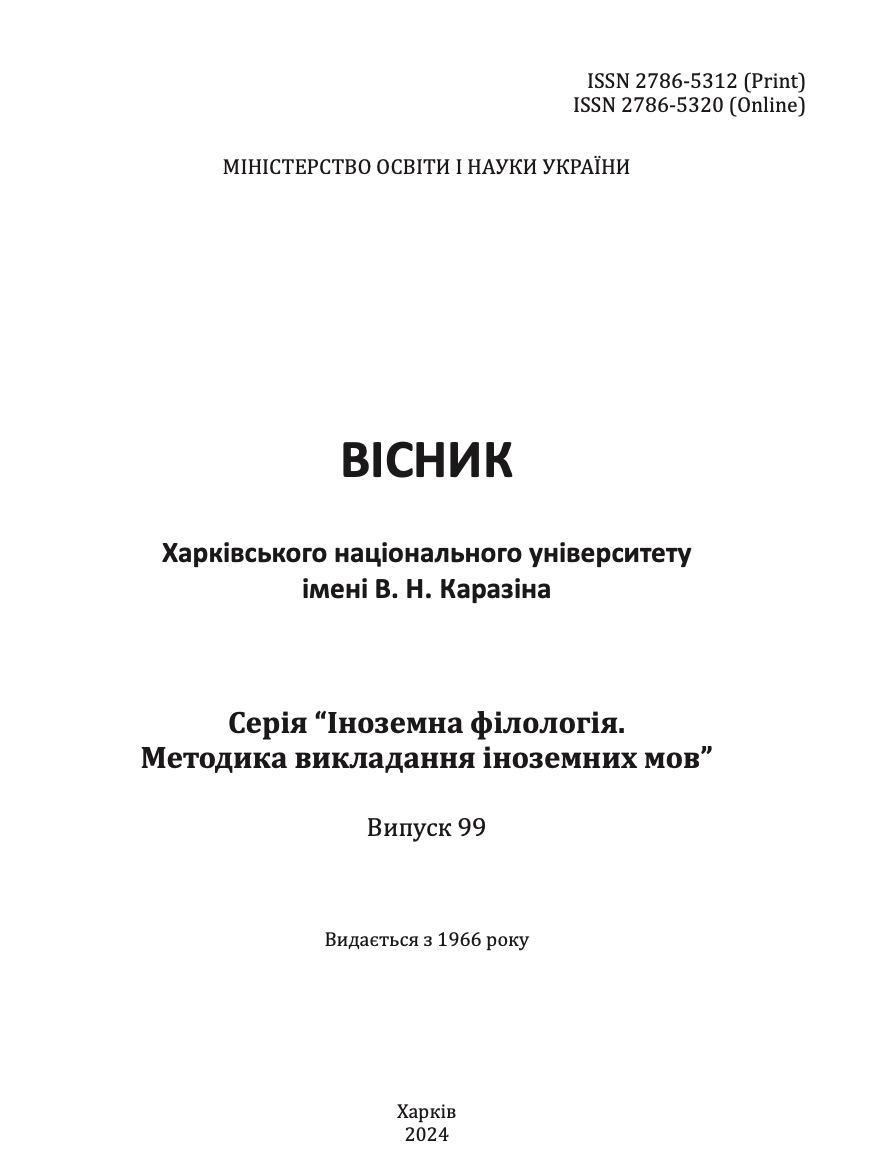Reproductive and Adaptive Strategies in Translating Comparative Units (on the Material of the Italian, English and Ukrainian Languages)
Abstract
The article deals with the problem of rendering comparative units of the Italian language into English and Ukrainian through the lens of the translation strategies of domestication and foreignization. Considering translation as one of the means of intercultural communication, the main research question addresses the effectiveness of the chosen strategies in conveying all the meanings of the original text to the translated language. The study aims to analyze how the above-mentioned strategies influence the perception of comparison and comparative units in various cultural contexts, i.e., in English and Ukrainian translations. The twofold nature of the image underlying the comparative unit might represent certain difficulties due to its national and cultural component or intricate, elaborate associative connections, especially in the case of ad hoc comparisons which are characterized by their novelty and/or unpredictability of associations between the object and its referent. This determines the relevance of the present research. Both translation strategies have their advantages and disadvantages. The data received allow us to talk about the priority of a certain strategy within a certain cultural context / language. English translation tends to reproduce the image of comparative units as accurately and precisely as possible, compensating a certain lack of attention to possible linguistic and cultural patterns and readers’ preferences with accuracy, consistency, and original style, which allow obtaining a holistic and coherent picture in the target language. Whereas the Ukrainian translation gives preference to greater dynamics, using adaptive strategies in rendering images and compensates for certain semantic losses at the expense of «proper», understandable images, which should potentially contribute to effective communication and meet reader’s expectations.
Downloads
References
Demets’ka, V. (2010). Reproduktyvnyj pereklad vs adaptyvnyj pereklad [ «reproductive translation» and «adaptive translation»]. Visnyk Dnipropetrovs’koho universytetu. Seriia «Movoznavstvo», 16, 97-103. (in Ukrainian)
Eco, U. (2004). Six walks in the fictional woods. Harvard University Press.
Kim, D. (2015). Dynamic equivalence: Nida’s perspective and beyond. SKASE Journal of Theoretical Linguistics, 8. 60-75.
Levý, J. (2011). The Art of Translation. John Benjamins Publishing.
Mizin, K. (2009). Porivniannia u frazeolohii [Comparison in phraseology]. Vinnytsia: Nova Knyha. (in Ukrainian)
Molchko, O. (2015). Khudozhnie porivniannia iak katehoriia perekladoznavstva (na materiali ukrains’koi ta anhlijs’koi mov [Simile as a Translation Studies Category (based on the Ukrainian and English languages)] (Philolgy PhD thesis). L’viv: L’vivs’kyj Natsional’nyj universytet imeni Ivana Franka (in Ukrainian)
Nida, E. (1964). Toward a Science of Translating: With Special Reference to Principles and Procedures Involved in Bible Translating. Leiden: E.J. Brill.
Obdržálková, V. (2016). Translation as a decision-making process: an application of the model proposed by Jiří Levý to translation into a non-mother tongue. Mutatis Mutandis, 9(2). 306-327.
Pachlovska, O. (2022). “Casa dietro una stella” Tradurre la poesia: sublimazione dell’impossibile. Verbo modernista nella tradizione italiana e ucraina.
Rebrii, O. (2012). Suchasni kontseptsii tvorchosti u perekladi [Modern conceptions of creativity in translation]. Kharkiv: V.N. Karazin Kharkiv National University. (in Ukrainian)
Rebrii, O. (2020). Vstup do perekladoznavstva [ Introduction to Translation Studies]. Kharkiv: Kharkivs’kyj natsional’nyj universytet imeni V.N. Karazina. (in Ukrainian)
Rebrii, O., & Sysa Y. (2022). Natsional’ni stereotypy iak problema perekladu [National stereotypes as a translation problem]. Visnyk Kharkivs’koho natsional’noho universytetu imeni V. N. Karazina. Seriia “Inozemna filolohiia. Metodyka vykladannia inozemnykh mov”, 95. 44-51. (in Ukrainian)
Selivanova, O. (2006). Suchasna linhvistyka: terminolohichna entsyklopediia [modern linguistics: directions and problems]. Poltava: Dovkillia-K. (in Ukrainian)
Venuti, L. (2008). The Translator’s Invisibility: A History of Translation. Routledge.
Venuti, L. (1991). Genealogies of Translation Theory: Schleiermacher. Traduction, terminologie, rédaction, 4(2). 125-150.
Zasiekina, L., & Zasiekin S. (2002). Vstup do psykholingvistyky [Introduction to Psycholinguistics]. Ostroh: National University Ostroh Academy. (in Ukrainian)
Zorivchak, R. (1983). Frazeolohichna odynytsia iak perekladoznavcha katehoriia (na materiali perekladiv tvoriv ukrains’koi literatury anhlijs’koiu movoiu) [The Phraseological Unit as a Translation Category (on the Material of Translations of Ukrainian Literature into English)]. Lviv: L’vivs’kyj derzhavnyj universytet. (in Ukrainian)
Cambridge Dictionary Online (2024). Retrieved from https://dictionary.cambridge.org/dictionary/english/
Ferrante, E. (2020). L’amica geniale, Vol. 1. Edizioni e/o
Ferrante, E. (2018). My brilliant friend. Europa editions.
Ferrante, E. (2020). Moia nejmovirna podruha. Knyzhkovyj klub «Klub Simejnoho Dozvillia». (in Ukrainian)




